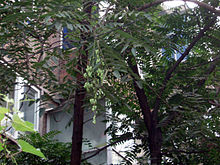Map Snapshot


1 Record
Seasonality Snapshot
No images available
Source: Wikipedia
| Toona sinensis | |
|---|---|

| |
| Foliage and seed capsules | |
| Scientific classification | |
| Kingdom: | Plantae |
| Clade: | Tracheophytes |
| Clade: | Angiosperms |
| Clade: | Eudicots |
| Clade: | Rosids |
| Order: | Sapindales |
| Family: | Meliaceae |
| Genus: | Toona |
| Species: | T. sinensis
|
| Binomial name | |
| Toona sinensis | |
| Synonyms | |
|
Synonyms list
| |



Toona sinensis, commonly called Chinese mahogany,[2] Chinese cedar, Chinese toon, beef and onion plant,[3] or red toon (Chinese: 香椿; pinyin: xiāngchūn; Korean: 참죽, romanized: chamjuk; Hindi: डारलू, romanized: d̩āralū; Malay: suren; Vietnamese: hương xuân) is a species of Toona native to eastern and southeastern Asia, ranging from northern Korean peninsula through most of eastern, central, and southwestern China, in Nepal, northeastern India, Burma (Myanmar), Thailand, and even present in Malaysia and western Indonesia.[4][5][6][7][8]
Characteristics
[edit]
It is a deciduous tree growing to 25 metres (82 ft) tall with a trunk up to 70 cm diameter. The bark is brown, smooth on young trees, becoming scaly to shaggy on old trees. The leaves are pinnate, 50–70 cm long and 30–40 cm broad, with 10–40 leaflets, the terminal leaflet usually absent (paripinnate) but sometimes present (imparipennate); the individual leaflets 9–15 cm long and 2.5–4 cm broad, with an entire or weakly serrated margin. The young leaves are reddish-brown or purple, and have a smell. The flowers are produced in summer in panicles 30–50 cm long at the end of a branch; each flower is small, 4–5 mm diameter, with five white or pale pink petals. The fruit is a golden capsule 2–3.5 cm long, containing several winged seeds.[4][7][8][9]
It is similar to Ailanthus altissima in appearance, but their leaves smell differently. Toona has rough bark, while A. altissima has smooth bark.
Cultivation
[edit]Toona sinensis can reproduce both sexually and asexually, including seed propagation, cutting propagation and tissue culture.
Seed propagation can provide large quantity of seedlings, which is suitable for the need of mass cultivation. Seeds soaked in warm water for a moderate amount of time before sowing are more likely to germinate. Normally, seeds of T. sinensis are sowed between the late March and early April in East Asia, and the time may vary depending on the actual planting area. Saplings grown from seeds in spring can be transplanted with leaves in fall.[10]
Cutting propagation uses a piece of stem or root of mature plant to grow a new plant in media like moist soil. This method has a higher survival rate in saplings than other methods. Usually semi-lignified stems are used in planting because those that have undergone full lignification process are hard to take root or root slowly and stems that have not lignified are easy to decay after planting. NAA or Vitamin D solutions can help with the rooting of cut stems. Normally, T. sinensis stems are cut from mature plant and cultivated between late June and early July in East Asia, and time may differ depending on the actual planting area.[10]
Tissue culture of T. sinensis started from the late 1980s in China. Successful cases include the culture of T. sinensis seedlings on MS medium together with IAA and BA hormones. Since the 1980s, researchers have collected stems of mature T. sinensis trees from different regions and built a set of methods specifically for the tissue culture of rare varieties of Toona sinensis.[11]
Uses
[edit]Food and Nutrition
[edit]The young leaves of T. sinensis are extensively used as a vegetable in Chinese cuisine; they have a floral, yet onion-like flavor, attributed to volatile organosulfur compounds.[12] Plants with red young leaves are considered of better flavour than those where the young leaves are green.[4][13][14]
In China and Southeast Asian countries such as Malaysia, the young leaves of Toona sinensis or commonly known as Chinese Mahogany is used to make Toona paste, which is used as a condiment to serve with plain rice porridge as breakfast and simple meals, or to enhance the flavour of a dish or soup. Common dishes made with Toona paste are Chinese Mahogany fried rice, Chinese Mahogany beancurd, and Chinese Mahogany mushroom soup.
The leaves contain Vitamin E, and high amounts of iron, calcium and chlorophyll.[15]
Lumber and landscape use
[edit]The timber is hard and reddish; it is valuable, used for furniture,[4][9] musical instruments such as guitars, and in woodcarving. This is a common (and substantially cheaper) replacement for Swietenia or "true mahogany", which is now commercially restricted from being sourced natively.[16]
Outside Asia, T. sinensis is valued more as a large ornamental tree for its haggard aspect.[8][17] It is by far the most cold-tolerant species in the Meliaceae and the only member of the family that can be cultivated successfully in northern Europe.
Medicine
[edit]According to Traditional Chinese Medicine (TCM), the leaves of T. sinensis are beneficial for digestion and cough problems, and can help to stop bleeding.[18]
Recent researches find out that polysaccharides contained in T. sinensis leaves can protect liver cells in high-fat or high-carbohydrate diets.[19][20] Quercetin extracted from leaves is found a natural antioxidant, and can act as a cancer preventive.[21]
Chemical constituents
[edit]The leaves of T. sinensis has a relative high content of nitrite, which is about 157 to 160 mg/kg.[22] However, after boiling with water, the amount of nitrite left is only about 7 mg/kg, which is safe to eat. Because the content of nitrite will increase as time passes, T. sinensis leaves are not suitable for long time storage.

The quercetin contained in T. sinensis leaves can induce cell cycle arrest and lead to apoptosis of cells.[23]
Culture
[edit]In Chinese literature, Toona sinensis is often used symbolically, with a mature tree representing a father. This manifests itself occasionally when expressing best wishes to a friend's father and mother in a letter, where one can write "wishing your Toona sinensis and daylily are strong and happy" (simplified Chinese: 椿萱并茂; traditional Chinese: 椿萱並茂; pinyin: chūnxuānbìngmào), with Toona sinensis metaphorically referring to the father and daylily to the mother.
References
[edit]- ^ "Toona sinensis (Juss.) M.Roem. — The Plant List". www.theplantlist.org.
- ^ Yousheng, C.; Sziklai, O. (1985), "Preliminary study on the germination of Toona sinensis (A. Juss.) roem. seed from eleven Chinese provenances", Forest Ecology and Management, 10 (3): 269–281, doi:10.1016/0378-1127(85)90119-7
- ^ "Beef and Onion Plant Seeds | Suttons". www.suttons.co.uk.
- ^ a b c d Hua Peng, David J. Mabberley, Caroline M. Pannell, Jennifer M. Edmonds & Bruce Bartholomew. "Toona sinensis". Flora of China. Missouri Botanical Garden, St. Louis, MO & Harvard University Herbaria, Cambridge, MA. Retrieved 25 May 2012.
{{cite web}}: CS1 maint: multiple names: authors list (link) - ^ "Toona sinensis". Germplasm Resources Information Network. Agricultural Research Service, United States Department of Agriculture. Retrieved 1 January 2018.
- ^ University of Melbourne: Sorting Toona names
- ^ a b Hong Kong trees: Toona sinensis (in Chinese, with photos; google translation)
- ^ a b c Rushforth, K. (1999). Trees of Britain and Europe. Collins ISBN 0-00-220013-9.
- ^ a b Taiwan Forestry: Toona sinensis (in Chinese, with photos; google translation)
- ^ a b "香椿树_香椿树的养殖方法/香椿树的养护知识 - 花卉网". www.aihuhua.com. Retrieved 2022-04-25.
- ^ "香椿的繁殖与栽培技术". www.agri.cn. Retrieved 2022-04-25.
- ^ Li J.-X., Eidman K., Gan X.-W., Haefliger O. P., J. Carroll P. J., Pika J. "Identification of (S,S)‑γ-glutamyl‑(cis-S‑1-propenyl)thioglycine, a naturally occurring norcysteine derivative, from the Chinese vegetable Toona sinensis." Journal of Agricultural and Food Chemistry 2013 61 (7470−7476).
- ^ Plants for a Future: Toona sinensis
- ^ Oriental Vegetable Seeds: Toona sinensis
- ^ Brassica (2022-03-25). "Chinese toon (Toona sinensis)". World Vegetable Center. Retrieved 2022-04-19.
- ^ "CITES TRADE CONTROLS TO TAKE EFFECT FOR MAHOGANY | Meetings Coverage and Press Releases". 2016-06-05. Archived from the original on 2016-06-05. Retrieved 2021-10-18.
- ^ More, D. & White, J. (2003). Cassell's Trees of Britain & Northern Europe. London: Weidenfeld & Nicolson. p. 709
- ^ You, Cixiong; 尤次雄 (2013). Xiang cao yang sheng shu shi. Yizhen Cai, 蔡怡贞 (Chu ban ed.). Taibei Shi. ISBN 978-986-5837-11-2. OCLC 872323641.
{{cite book}}: CS1 maint: location missing publisher (link) - ^ Cao, Juan-Juan; Lv, Qing-Qing; Zhang, Bao; Chen, Han-Qing (2019-05-15). "Structural characterization and hepatoprotective activities of polysaccharides from the leaves of Toona sinensis (A. Juss) Roem". Carbohydrate Polymers. 212: 89–101. doi:10.1016/j.carbpol.2019.02.031. ISSN 0144-8617. PMID 30832884. S2CID 73476781.
- ^ Zhang, Yali; Dong, Huanhuan; Wang, Mimi; Zhang, Jingfang (2016). "Quercetin Isolated from Toona sinensis Leaves Attenuates Hyperglycemia and Protects Hepatocytes in High-Carbohydrate/High-Fat Diet and Alloxan Induced Experimental Diabetic Mice". Journal of Diabetes Research. 2016: 8492780. doi:10.1155/2016/8492780. ISSN 2314-6753. PMC 5126429. PMID 27975068.
- ^ Mil, Foppe (2007-11-29). "Editorial". Pharmacy World & Science. 30 (2): 146. doi:10.1007/s11096-007-9175-2. ISSN 0928-1231.
- ^ "香椿亚硝酸盐含量高 用沸水焯后再吃--环保--人民网". 2007-03-07. Archived from the original on 7 March 2007. Retrieved 2022-04-25.
- ^ Zhang, Yali; Guo, Yucheng; Wang, Mimi; Dong, Huanhuan; Zhang, Jingfang; Zhang, Liyu (2017-12-01). "Quercetrin from Toona sinensis leaves induces cell cycle arrest and apoptosis via enhancement of oxidative stress in human colorectal cancer SW620 cells". Oncology Reports. 38 (6): 3319–3326. doi:10.3892/or.2017.6042. ISSN 1021-335X. PMC 5783577. PMID 29039609.
